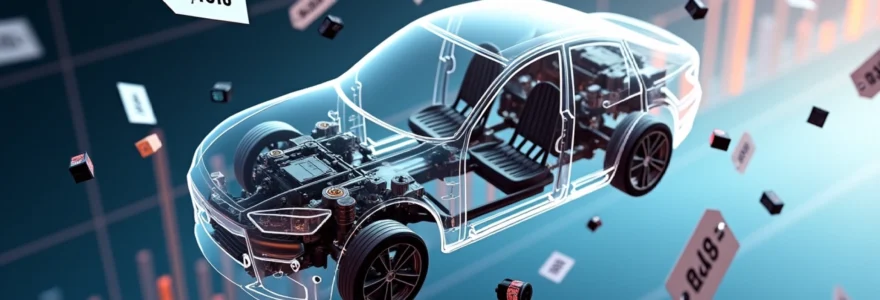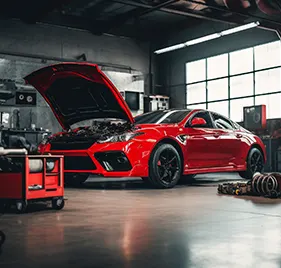The automotive industry is experiencing significant shifts in car part pricing, driven by a complex interplay of market forces, technological advancements, and global economic factors. Understanding these dynamics is crucial for consumers, manufacturers, and industry professionals alike. From raw material fluctuations to regulatory changes, the pricing landscape for automotive components is evolving rapidly, affecting everything from routine maintenance costs to the overall affordability of vehicle ownership.
Market dynamics influencing automotive component pricing
The pricing of car parts is not a simple matter of production costs plus markup. It’s a complex equation influenced by numerous market forces. Global demand, currency fluctuations, and competitive pressures all play significant roles in determining the final cost of automotive components. For instance, the rise of electric vehicles has created new demand for specific parts, potentially driving up prices in that sector while traditional combustion engine components may see price stabilization or even decreases.
Moreover, the consolidation of part manufacturers through mergers and acquisitions can lead to reduced competition and potentially higher prices. Conversely, the entry of new players, particularly from emerging markets, can introduce price competition and drive costs down. These market dynamics create a constantly shifting landscape where pricing strategies must be agile and responsive.
Supply chain complexities in car parts manufacturing
The supply chain for automotive parts is a global network of unprecedented complexity. This intricate system is susceptible to disruptions that can have far-reaching effects on pricing. Understanding these complexities is key to grasping why car part prices can fluctuate so dramatically.
Raw material fluctuations: steel, aluminum, and plastics
The cost of raw materials forms the foundation of car part pricing. Steel, aluminum, and various plastics are the building blocks of most automotive components. When the prices of these materials fluctuate, it sends ripples through the entire supply chain. A surge in steel prices can dramatically increase the cost of body panels, chassis components, and engine parts.
In recent years, we’ve seen significant volatility in raw material markets. Trade disputes, environmental regulations, and production bottlenecks have all contributed to price instability. Manufacturers often attempt to absorb short-term fluctuations, but prolonged price increases inevitably lead to higher costs for consumers.
Global logistics challenges: port congestions and shipping costs
The global nature of the automotive supply chain means that logistics play a crucial role in pricing. Port congestions, as seen during the COVID-19 pandemic, can cause significant delays and increase shipping costs. When it costs more to transport parts from manufacturers to assembly plants or distribution centers, these expenses are often reflected in the final price tag.
Shipping container shortages and fuel price spikes further complicate the logistics picture. These factors can lead to situations where the cost to ship a part might temporarily exceed the production cost, forcing manufacturers to reevaluate their pricing strategies.
Just-in-time manufacturing: inventory management impacts
Many automotive manufacturers have adopted Just-In-Time (JIT) manufacturing principles to reduce inventory costs and improve efficiency. While effective under normal circumstances, JIT systems are vulnerable to supply chain disruptions. When parts aren’t available at the exact moment they’re needed, it can lead to production delays and increased costs.
The fragility of JIT systems was exposed during recent global events, leading some manufacturers to reconsider their inventory strategies. This shift towards keeping larger inventories of critical components may increase costs in the short term but could provide more stability in pricing over time.
Semiconductor shortages: ECU and infotainment system pricing
The automotive industry’s increasing reliance on electronic components has made it particularly vulnerable to semiconductor shortages. Electronic Control Units (ECUs) and infotainment systems are now integral to modern vehicles, and the scarcity of chips has led to significant price increases in these components.
As vehicles become more technologically advanced, the demand for semiconductors in the automotive sector is expected to grow. This ongoing pressure on the semiconductor supply chain could continue to impact pricing for electronic car parts in the foreseeable future.
OEM vs aftermarket parts: cost analysis
When it comes to replacing car parts, consumers often face a choice between Original Equipment Manufacturer (OEM) components and aftermarket alternatives. This decision can have significant implications for both cost and quality.
Quality differentials: genuine vs. Third-Party components
OEM parts are designed to meet the exact specifications of the vehicle manufacturer. They often come with a higher price tag but offer the assurance of perfect fitment and compatibility. Aftermarket parts, on the other hand, can vary widely in quality. Some may meet or even exceed OEM standards, while others may be of inferior quality.
The price difference between OEM and high-quality aftermarket parts can be substantial. For example, an OEM air filter might cost 50% more than a premium aftermarket alternative. However, the long-term cost implications of choosing lower-quality parts can be significant if they lead to reduced performance or more frequent replacements.
Warranty considerations: extended coverage costs
Warranty coverage is an important factor in the pricing equation. OEM parts often come with warranties that match or exceed those of the original vehicle. This extended coverage can justify higher upfront costs by providing peace of mind and potential long-term savings.
Aftermarket parts may offer their own warranties, but these can vary widely in terms and coverage. When considering the total cost of ownership, it’s crucial to factor in the potential expenses associated with part failures outside of warranty periods.
Brand premium: pricing strategies of major manufacturers
Major automotive manufacturers often command a premium for their branded parts. This premium is based on brand reputation, perceived quality, and the assurance of compatibility. However, the actual cost difference between a branded part and a generic equivalent can be substantial.
A branded oil filter from a luxury car manufacturer might cost three times as much as a generic filter of comparable quality. Consumers must weigh the perceived benefits of the brand against the potential cost savings of choosing alternative suppliers.
Technological advancements driving price shifts
The rapid pace of technological innovation in the automotive industry is having a profound impact on car part pricing. As vehicles become more advanced, the components that make them run are evolving, often becoming more complex and expensive.
ADAS components: LiDAR and radar sensor costs
Advanced Driver Assistance Systems (ADAS) are becoming standard features in many new vehicles. These systems rely on sophisticated sensors, including LiDAR (Light Detection and Ranging) and radar, to function. The cost of these components can be significant, often running into thousands of dollars for a single sensor.
As ADAS technology becomes more prevalent, economies of scale are expected to bring down costs over time. However, in the short term, the inclusion of these advanced systems is contributing to higher vehicle prices and increased repair costs in the event of damage.
Electric vehicle parts: battery pack and motor pricing trends
The shift towards electric vehicles (EVs) is introducing new pricing dynamics in the automotive parts market. Battery packs, the most expensive component in an EV, have seen significant price reductions in recent years. However, they still represent a substantial portion of the vehicle’s cost.
Electric motors and power electronics are also specialized components that can be more expensive than their internal combustion engine counterparts. As EV production scales up, prices for these components are expected to decrease, but they currently contribute to higher upfront costs for electric vehicles.
Lightweight materials: carbon fiber and composite pricing
The pursuit of improved fuel efficiency and performance has led to increased use of lightweight materials in vehicle construction. Carbon fiber and advanced composites offer significant weight savings but come at a premium price.
While primarily used in high-end and performance vehicles, these materials are gradually making their way into mainstream production. The high cost of carbon fiber components, often 5-10 times more expensive than steel equivalents, impacts both initial vehicle pricing and replacement part costs.
Regulatory impacts on car part pricing
Government regulations play a significant role in shaping the automotive industry, including the pricing of car parts. As standards for emissions, safety, and fuel efficiency become more stringent, manufacturers must adapt their products, often leading to increased costs.
Emissions standards: catalytic converter and DPF costs
Stricter emissions regulations have led to more complex and expensive exhaust systems. Catalytic converters, which contain precious metals like platinum and palladium, have seen price increases due to both material costs and more stringent performance requirements.
Diesel Particulate Filters (DPFs) are another component that has become more sophisticated and expensive due to emissions regulations. The cost of replacing a DPF can be substantial, often running into thousands of dollars, impacting the long-term ownership costs of diesel vehicles.
Safety regulations: airbag and ABS system pricing
Safety standards continue to evolve, requiring more advanced safety systems in vehicles. Modern airbag systems, for instance, are more complex than ever, with multiple deployment zones and sophisticated sensors. This complexity translates to higher costs for both initial installation and replacement.
Anti-lock Braking Systems (ABS) and stability control systems have also become more advanced to meet safety regulations. While these systems improve vehicle safety, they also add to the overall cost of the vehicle and increase the expense of repairs when components fail.
Intellectual property: patent licensing fees in component costs
The automotive industry is highly innovative, with manufacturers and suppliers constantly developing new technologies. These innovations are often protected by patents, which can lead to licensing fees being built into the cost of components.
Certain hybrid vehicle technologies or advanced infotainment systems may require manufacturers to pay licensing fees to use patented designs or software. These costs are ultimately passed on to consumers in the form of higher prices for both vehicles and replacement parts.
Consumer strategies for navigating part prices
Given the complex factors influencing car part prices, consumers need effective strategies to manage costs without compromising on quality or safety. There are several approaches that savvy car owners can take to navigate the often confusing world of automotive parts pricing.
Price comparison tools: RockAuto and PartsTrain utilization
Online price comparison tools have revolutionized the way consumers shop for car parts. Websites like RockAuto and PartsTrain allow users to quickly compare prices across multiple brands and suppliers. These platforms often offer significant savings compared to traditional brick-and-mortar auto parts stores.
When using these tools, it’s important to consider factors beyond just price. Look for parts with good customer reviews and check the warranty offerings. Also, be aware of shipping costs, which can sometimes negate the savings on cheaper parts.
Remanufactured parts: quality and cost considerations
Remanufactured parts offer a middle ground between new OEM components and used parts. These are typically original parts that have been disassembled, cleaned, and rebuilt to meet specific quality standards. They often come with warranties comparable to new parts but at a fraction of the cost.
A remanufactured alternator might cost 30-50% less than a new OEM unit while offering similar performance and reliability. However, it’s crucial to purchase remanufactured parts from reputable sources to ensure quality and proper warranty coverage.
DIY vs professional installation: labor cost analysis
The decision to install parts yourself or hire a professional can significantly impact the overall cost of car maintenance and repairs. While DIY installation can save on labor costs, it’s important to realistically assess your skills and the complexity of the job.
Simple tasks like replacing air filters or wiper blades are generally safe for most DIY enthusiasts. However, more complex repairs involving electrical systems or critical safety components are often best left to professionals. When considering DIY, factor in the cost of any special tools required and the potential for costly mistakes if the installation goes wrong.

